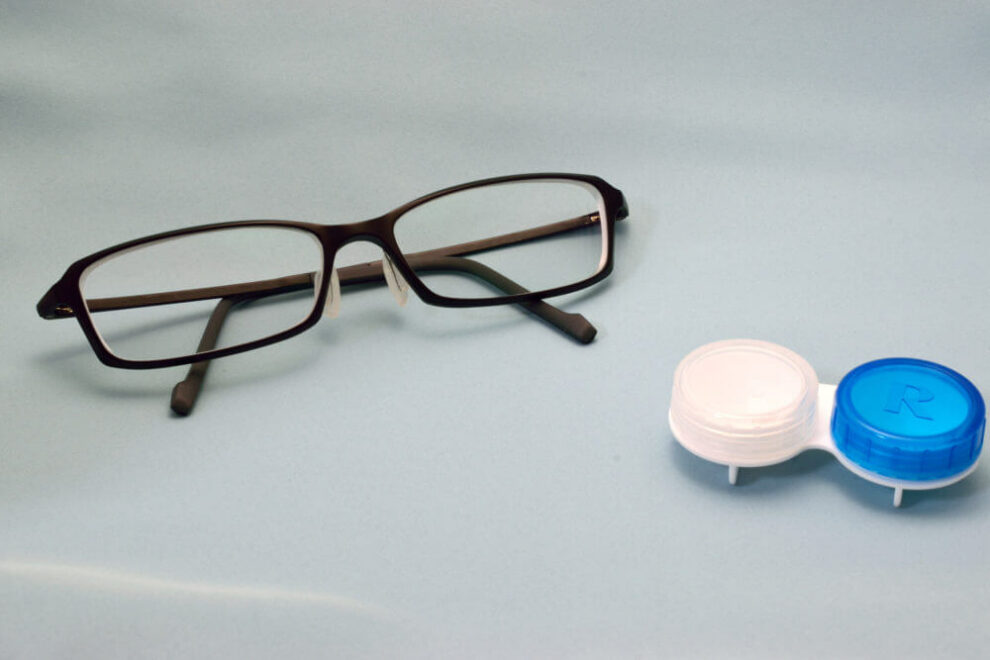Posted by: Kentucky Eye Institute in Vision Care

61% of the American population relies on corrective lenses to see. That’s up 4% from over a decade ago. The growing population of glasses and contact wearers is not only made up of the elderly, either.
20 percent of millennials use corrective lenses, too. If you ever see the eye doctor and discover you need glasses or contacts, don’t panic. There are various pros and cons of each you should know about.
When it comes to choosing glasses vs. contacts, it’s going to come down to how they fit your lifestyle and personality.
Glasses vs. Contacts: An Overview
Let’s start with the basics of each type of corrective lenses. Technology has allowed a variety of lens material and structures to correct vision. Here is a brief overview of what is available.
Glasses
Glasses come in two types: single vision and multifocal. Single-vision is for distance correction for those who are near-sighted or far-sighted. Multi-focal corrects both distance issues and reading issues.
You can have a simple bi-focal for far-sighted correction and reading, separated into two clear halves. Trifocals cover both of these areas, plus a third area for anything in between. Finally, progressive lenses take multi-focal lenses and blend them together in a seamless transition.
Materials and Coatings
Glasses aren’t actually made of glass, at least not anymore. They’re made from a variety of plastic polymers. Some lens materials are more durable than actual glass.
Polycarbonate lenses are made the same way safety glasses are, giving strong resistance to scratches and breaks. On the opposite end of the spectrum, you have high-index lenses, which are lighter and thinner than other lenses. They offer higher prescription options but are more fragile than polycarbonate.
Eyeglasses can also take on additional protective coatings, such as UV and dust-resistance. Photochromic lenses offer a hybrid sunglasses option, which darkens the tint when exposed to sunlight. These are all beneficial to people with sensitive eyes.
Contact Lenses
There are two types of contact lenses: hard (glass) and soft (plastic). They sit directly on the eye, with a buffer of water/tears. The soft contacts are lighter and hold onto more water.
While you can get bifocal and multi-focal contacts, they aren’t quite as effective as glasses. Contact lenses get separate coatings to allow for near and far distance focusing. It takes a bit of practice and adjusting to the contacts to work reliably.
Hard contacts are generally known as daily wear lenses. They are only good for a day before needing cleaning and protected from drying out. There are also disposable contacts you wear for a day and then throw them out.
Contacts that are made for weekly use don’t need cleaning every night. They can last up to 1-2 weeks before cleaning. Extended wear contact lenses are usually soft contact lenses made of a special hydrogel material.
Hard contact lenses can last longer than soft ones, however, they are less comfortable to wear. People with astigmatism prefer hard contacts for better accuracy.
Pros and Cons
Don’t let one or two experiences form your opinion on glasses vs. contacts. There are too many variables that can affect someone’s opinion on either one. Here are some facts about each type of corrective lens.
Glasses: Pros
Eyeglasses are simple. You, wipe them off every once in a while, put them on, and they stay. No bothering with cleaning solutions, required replacements, and etc.
You can browse an assortment of casings to accommodate your style. As long as you get yearly eye exams, you don’t need to change your glasses regularly. That results in them being less expensive than contacts.
Additionally, you don’t need to mess with your eyes. You can take your glasses off and put them on whenever you need. Forgetting to take your contacts out when you sleep is a common hassle.
Glasses: Cons
They can twist vision, particularly at the edge of the focal point with astigmatism. You might hate the irritation of the glasses on your nose or the weight on your ears. A few people don’t care for how they look in glasses.
They can mist up and become useless in a downpour. They may not be the best decision for games or different exercises. You’ll have to invest in glasses accessories and protective coatings.
Contacts: Pros
They give you more vision real estate than glasses. They will never get in the way with what you see. They don’t mist up or get wet when it’s cold or foggy.
Contacts don’t act as a burden when you play sports. There’s no chance for light to bounce off your contacts in front of a bright screen.
Contacts: Cons
They need significantly more consideration than glasses. You must clean and store them the correct way. You can damage your eyes if you take poor care of your contacts.
Bacteria, dirt, and small particles can get trapped in between the contacts and the eye. With high astigmatism, your vision may get foggy when contacts aren’t centered. Special contacts for astigmatism or trifocals are very costly.
They’re more costly than glasses and normally require more testing and follow-ups with your eye specialist.
Final Verdict
If you’re having vision problems, don’t wait until you’re forced to get glasses. The longer you go without corrective lenses, the worse your vision becomes. The same goes for anyone already using glasses or contacts.
Get an eye exam at least every two years. Older adults (age 61 and older) should have annual exams. While it may sound expensive needing new lenses every other year, it’s more expensive if your prescription strength jumps higher.
Find out where your vision is at right now by contacting us today. Our eye doctors will give you more details on the differences between glasses vs. contacts. We offer financing options so that everyone can have a clear vision of their future.
